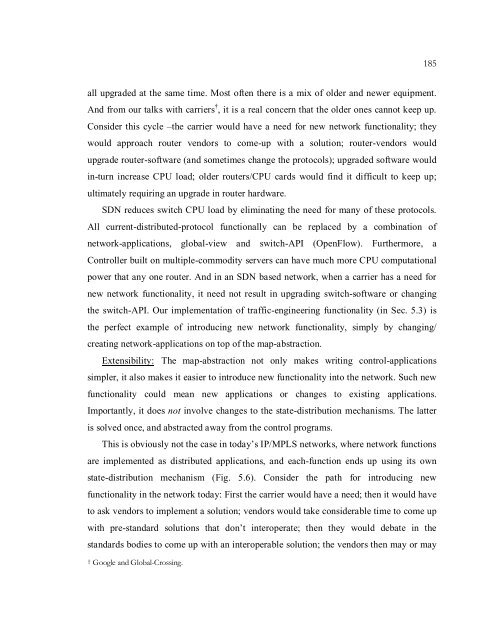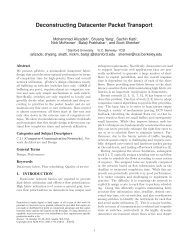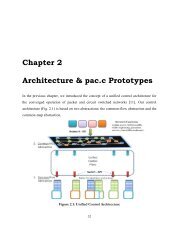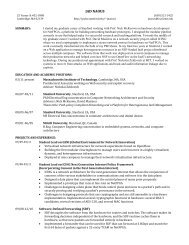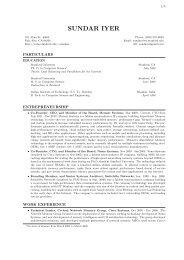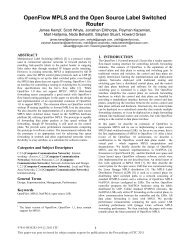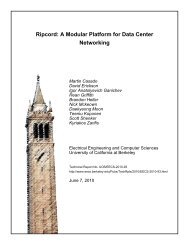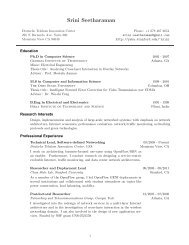Chapter 5 Introducing SDN Control in MPLS Networks - High ...
Chapter 5 Introducing SDN Control in MPLS Networks - High ...
Chapter 5 Introducing SDN Control in MPLS Networks - High ...
Create successful ePaper yourself
Turn your PDF publications into a flip-book with our unique Google optimized e-Paper software.
185all upgraded at the same time. Most often there is a mix of older and newer equipment.And from our talks with carriers † , it is a real concern that the older ones cannot keep up.Consider this cycle –the carrier would have a need for new network functionality; theywould approach router vendors to come-up with a solution; router-vendors wouldupgrade router-software (and sometimes change the protocols); upgraded software would<strong>in</strong>-turn <strong>in</strong>crease CPU load; older routers/CPU cards would f<strong>in</strong>d it difficult to keep up;ultimately requir<strong>in</strong>g an upgrade <strong>in</strong> router hardware.<strong>SDN</strong> reduces switch CPU load by elim<strong>in</strong>at<strong>in</strong>g the need for many of these protocols.All current-distributed-protocol functionally can be replaced by a comb<strong>in</strong>ation ofnetwork-applications, global-view and switch-API (OpenFlow). Furthermore, a<strong>Control</strong>ler built on multiple-commodity servers can have much more CPU computationalpower that any one router. And <strong>in</strong> an <strong>SDN</strong> based network, when a carrier has a need fornew network functionality, it need not result <strong>in</strong> upgrad<strong>in</strong>g switch-software or chang<strong>in</strong>gthe switch-API. Our implementation of traffic-eng<strong>in</strong>eer<strong>in</strong>g functionality (<strong>in</strong> Sec. 5.3) isthe perfect example of <strong>in</strong>troduc<strong>in</strong>g new network functionality, simply by chang<strong>in</strong>g/creat<strong>in</strong>g network-applications on top of the map-abstraction.Extensibility: The map-abstraction not only makes writ<strong>in</strong>g control-applicationssimpler, it also makes it easier to <strong>in</strong>troduce new functionality <strong>in</strong>to the network. Such newfunctionality could mean new applications or changes to exist<strong>in</strong>g applications.Importantly, it does not <strong>in</strong>volve changes to the state-distribution mechanisms. The latteris solved once, and abstracted away from the control programs.This is obviously not the case <strong>in</strong> today’s IP/<strong>MPLS</strong> networks, where network functionsare implemented as distributed applications, and each-function ends up us<strong>in</strong>g its ownstate-distribution mechanism (Fig. 5.6). Consider the path for <strong>in</strong>troduc<strong>in</strong>g newfunctionality <strong>in</strong> the network today: First the carrier would have a need; then it would haveto ask vendors to implement a solution; vendors would take considerable time to come upwith pre-standard solutions that don’t <strong>in</strong>teroperate; then they would debate <strong>in</strong> thestandards bodies to come up with an <strong>in</strong>teroperable solution; the vendors then may or may† Google and Global-Cross<strong>in</strong>g.


